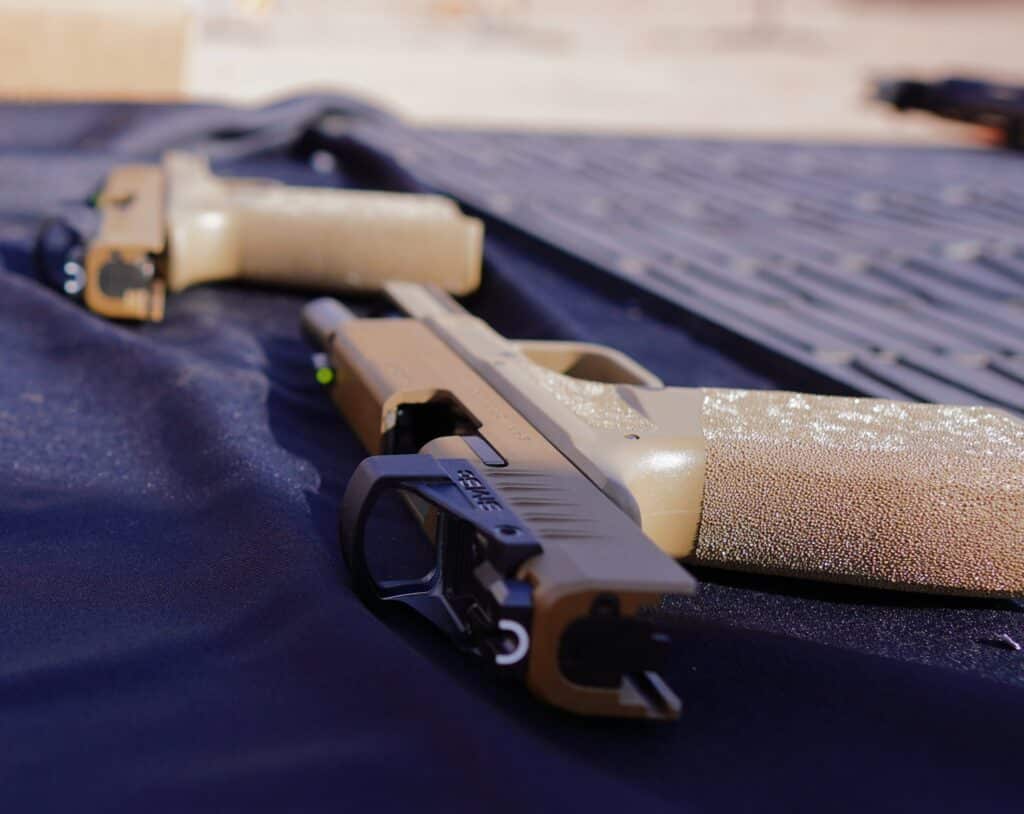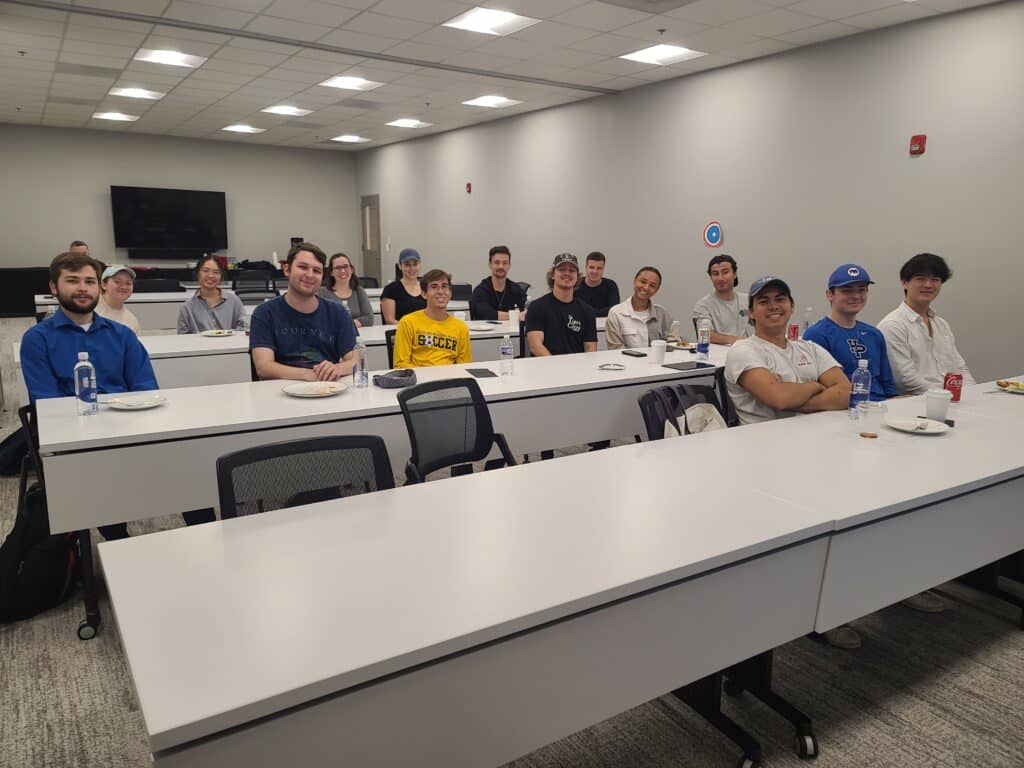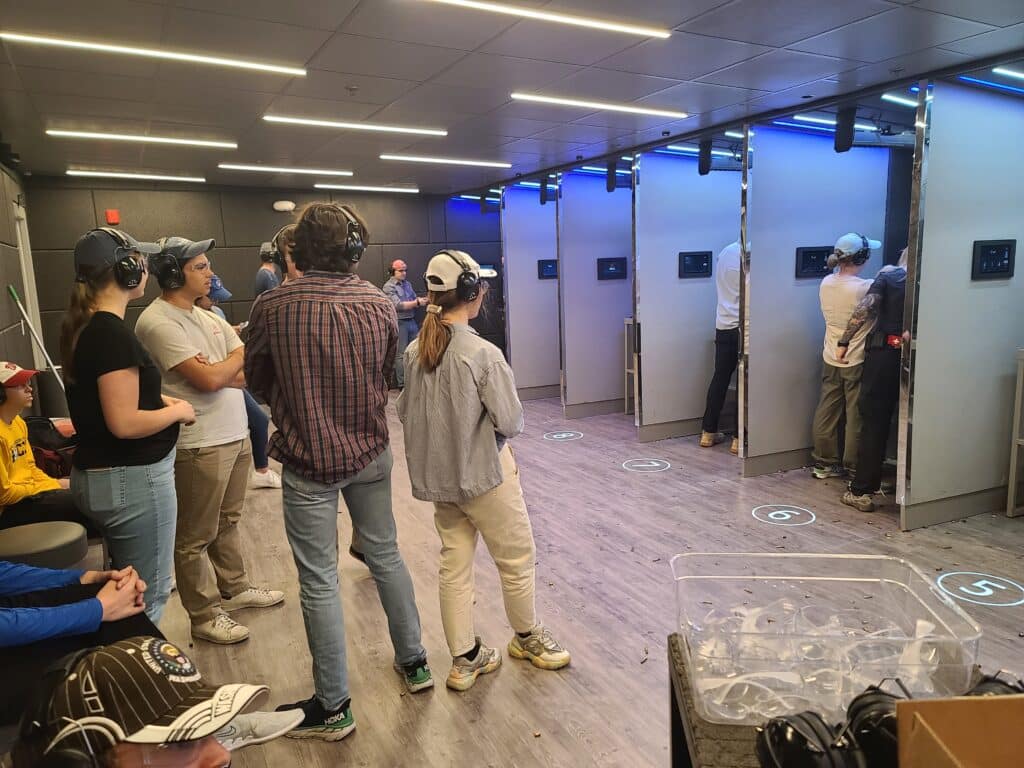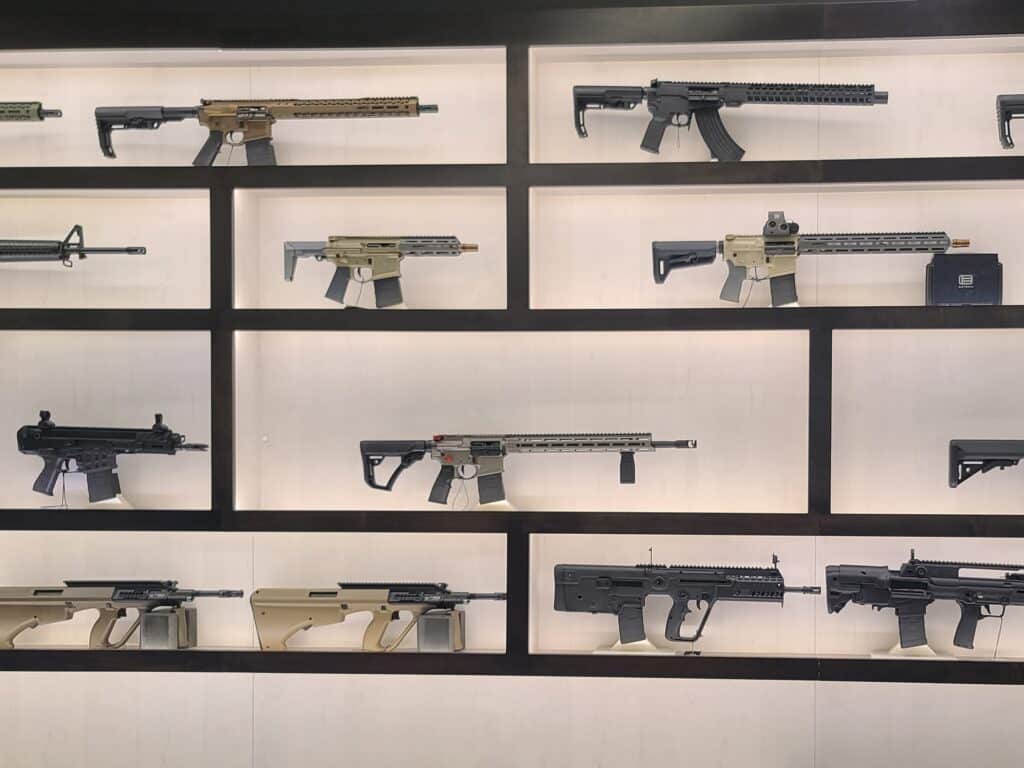We’re taking a close look at two different federal rulings in this week’s members’ email.
The first is out of Oregon. A judge there upheld the state’s magazine ban by finding the ammunition feeding devices aren’t “in common use” and are, therefore, outside the protection of the Second Amendment. Contributing Writer Jake Fogleman examines how the judge reached that conclusion and why the Supreme Court likely won’t agree.
The other case was in San Jose, California. A judge there upheld the city’s gun ownership tax and insurance mandate. I explain why the logic employed has a better shot of surviving at the High Court than hardware bans like the one in Oregon.
Plus, Ohio State University’s Sophie Kjaervik joins the podcast to explain her study on how a short video can prevent accidental shootings among kids. And I teach a bunch of journalism students about reporting on firearms during this year’s National Journalism Center’s range day.

Analysis: How Should the ‘In Common Use’ Standard Be Determined? [Member Exclusive]
By Jake Fogleman
A federal judge has now ruled that commonly-owned ammunition magazines do not fall under the Second Amendment’s protection. How she arrived at that conclusion may catch the Supreme Court’s eye.
Late last week, U.S. District Judge Karin Immergut, a Trump appointee, upheld Oregon’s ballot-initiated Measure 114. That law bans the possession and sale of magazines capable of holding more than ten rounds of ammo and institutes a permitting requirement to purchase a firearm. Immergut found that not only did the nation’s historical tradition of gun regulations support a ban on “Large-Capacity Magazines” (LCMs), but the Second Amendment’s plain text itself did not cover them.
“The evidence in the record illustrates that LCMs are not necessary for firearms to function and are not commonly used for self-defense,” Immergut wrote in her decision. “Because this Court finds that the Second Amendment’s plain text does not cover LCMs, BM 114’s restrictions on LCMs are constitutional.”
While Immergut is not the first federal judge to uphold a magazine ban after the Supreme Court’s ruling in New York State Rifle and Pistol Association v. Bruen, she is one of the first to do so by saying that they fall entirely outside the scope of the Second Amendment’s text. Before even arriving at the main part of the test outlined in Bruen, Immergut concluded that a ban on a commonly-owned firearm accessory, which typically comes standard with the purchase of most modern firearms, could pass constitutional muster.
It’s an analysis that essentially short-circuits Bruen, applied to one of the most hotly-contested policies in all of gun politics. If it catches on, it could have significant policy ramifications for blue jurisdictions nationwide searching for a legal basis to target disfavored magazines and other firearms hardware.
But it’s one that could also run into trouble at the Supreme Court.
In its Heller decision, the Court determined that the Second Amendment’s plain text protects arms “typically possessed by law-abiding citizens for lawful purposes.” The court further clarified the scope of this protection by drawing on the 1939 decision in United States v. Miller, stating, “Miller’s holding that the sorts of weapons protected are those ‘in common use at the time’ finds support in the historical tradition of prohibiting the carrying of dangerous and unusual weapons.”
This “common use” standard applies to the first prong of the Bruen test, which stipulates that “when the Second Amendment’s plain text covers an individual’s conduct, the Constitution presumptively protects that conduct.”
Judge Immergut’s decision quoted from Heller and Bruen about the Second Amendment’s text protecting weapons “in common use at the time” and “commonly used for lawful purposes.” But it also stitched together past comments from the justices on self-defense being the “central component” of the amendment to determine that defense was the only “lawful purpose” worth considering when evaluating the use of so-called large capacity magazines.
“This Court acknowledges that there may be lawful purposes other than self-defense for which an individual can use a firearm,” Immergut wrote. “While these uses may be lawful, they have never been explicitly recognized as being ‘the central component’ of the Second Amendment right; only self-defense enjoys that kind of unique focus within the Supreme Court’s caselaw. Accordingly, this Court finds that the Second Amendment protects an individual right to commonly used firearms for the central purpose of self-defense.”
Then, after removing all consideration of separate lawful activities where a magazine may be used by a gun owner, such as target shooting or hunting, she further whittled down the scope of what constitutes “common use for self-defense” by disregarding gun owners’ stated intent for selecting said magazines. Instead, she considered only documented defensive gun uses featuring large-capacity magazines.
“This Court finds that an individual’s subjective intent in purchasing a firearm or firearm accessory for self-defense, while relevant, also cannot be dispositive in assessing whether a firearm or firearm accessory is in common use for self-defense,” she wrote.
Immergut said that the plaintiffs failed to prove during trial that gun owners commonly needed eleven or more rounds for self-defense. Instead, the evidence Immergut found compelling was the testimony of a researcher who said she analyzed defensive gun use encounters documented by the NRA’s Armed Citizens Database, which simply aggregates publicly-available news stories of defensive gun uses. That researcher claimed an individual fired more than ten rounds in just two of the hundreds of incidents occurring over the period examined, though self-defense stories often don’t mention the number of rounds fired in an incident. Still, Judge Immergut concluded the report was enough evidence of an “objective standard” to show that “having more rounds does not facilitate self-defense.”
“Plaintiffs have not shown that LCMs are commonly employed for self-defense. Defendants have produced credible evidence showing that they are not,” she said. “This Court accordingly finds that the Second Amendment does not protect LCMs.”
This logic is one the Supreme Court could find fault with. It relies on a distinction between the “subjective” reasons why gun owners say they acquire and use a particular regulated item, and on supposedly “objective” metrics of them actually being used in self-defense incidents. It is a distinction the Supreme Court does not appear willing to make, at least if its ruling in Heller is any guide.
“It is no answer to say, as petitioners do, that it is permissible to ban the possession of handguns so long as the possession of other firearms (i.e., long guns) is allowed,” Justice Antonin Scalia wrote in the majority opinion. “It is enough to note, as we have observed, that the American people have considered the handgun to be the quintessential self-defense weapon. There are many reasons that a citizen may prefer a handgun for home defense: It is easier to store in a location that is readily accessible in an emergency; it cannot easily be redirected or wrestled away by an attacker; it is easier to use for those without the upperbody strength to lift and aim a long gun; it can be pointed at a burglar with one hand while the other hand dials the police. Whatever the reason, handguns are the most popular weapon chosen by Americans for self-defense in the home, and a complete prohibition of their use is invalid.”
In other words, an empirical demonstration of handguns specifically being used in the home for defense was not necessary for the Court to find that they are protected by the Second Amendment. It is sufficient to demonstrate through the revealed consumer preferences of gun owners that a given arm is “commonly used” for a lawful purpose like self-defense. And under that standard, it’s hard to see how large-capacity magazines do not similarly fall into that category.
The 2021 National Firearms Survey conducted by Georgetown professor William English, considered to be one of the largest and most comprehensive surveys of U.S. gun ownership, found that 48 percent of gun owners—or 39 million adults—said they’ve owned one or more magazines that hold more than ten rounds. Home defense and recreational target shooting were the two most common reasons indicated for owning the magazines.
Presumably, an accessory ostensibly owned by tens of millions of adults for home defense and recreational shooting would clear the bar of being “commonly used for lawful purposes.” But under Judge Immergut’s version of the “common use” analysis, it’s hard to see how almost any subcategory of firearm or accessory could not similarly be interpreted as being outside the scope of the Second Amendment. Possibly including ammunition magazines of nearly any size.
Given the current makeup of the Supreme Court, that’s not likely to be allowed to stand.
While the ruling is, for now, just one decision at the District Court level, there’s reason to think it has the potential to be influential. Second Amendment jurisprudence is still in its infancy under the new Bruen standard, and courts are still working out how to handle such cases as states continue passing new laws and advocates challenge them in court. Other judges, particularly those looking to find ways of upholding gun laws, will be taking note of any high-profile rulings doing so to date. It also now awaits review in the Ninth Circuit, which is prone to upholding gun laws. If the Ninth Circuit is sympathetic to Immergut’s analysis when it reaches its decision, it could reach a whole new level of visibility and precedential value.
If so, the Supreme Court will have to decide whether to step in and further clarify its view of what is and isn’t “in common use.”
Podcast: Can a Short Video Stop Accidental Shootings Among Kids? (With OSU’s Sophie Kjaervik) [Member Early Access]
By Stephen Gutowski
This week, we’re taking a close look at a new study that suggests showing kids a minute-long video stops them from handling a gun while unsupervised.
We are lucky enough to have Ohio State University PHD student, and lead author of the study, Sophie Kjaervik with us for this episode. She explained that kids in her experiment that watched a short gun safety video featuring a uniformed police officer were far less likely to pick up a real, but disabled, gun in a controlled setting than kids shown a car safety video with the same cop. And the difference was significant.
Kjaervik explained in depth how the researchers recruited the kids in the study, how they decided who watched which video, how they staged the guns, how they monitored the children, and collected data.
She also noted there were a few additional factors that signaled a kid would be less likely to handle the guns they found. Those included a dislike for guns, but also parents who owned guns and experience with some other form of gun safety training beforehand.
Overall, Kjaervik said the experiment showed that gun-safety videos are a viable way to prevent accidental shootings. But it also showed how efforts like the NRA’s Eddie Eagle program could be improved.
Plus, Contributing Writer Jake Fogleman and I examine the ruling upholding San Jose’s gun ownership tax and insurance mandate.
You can listen to the show on your favorite podcasting app or by clicking here. Video of the episode is available on our YouTube channel. Reload Members get access on Sunday, as always. The episode goes public on Monday.
The National Journalism Center’s Range Day
I was able to teach a class full of students some of the important ins and outs of reporting on firearms at the latest National Journalism Center’s range day on Friday. This is our third range day, and it went great. The interns were both respectful and curious.
Our own intern Stephen Bole was there and shot a gun for the very first time. He wasn’t the only one to get his first practical experience with a firearm either.
In addition to the trigger time, I also gave a lesson on basic firearms function and law. I did my best to explain many of the topics they’d likely run into during their careers if they ever end up reporting a gun-related story. We went over everything from the basic distinction between semi-automatic and fully-automatic to the details of how the background check system works in practice.
Everything went great. And I got to experience the facilities at XCal out in Loudon County, Virginia for the first time. It was quite fancy.
I was certainly impressed. They even had a knife nook, which is a room I hadn’t known I needed before now. If I ever strike it rich, I’m definitely getting a house with a knife nook.

Analysis: San Jose Gun Insurance, Tax Better Bet to Survive SCOTUS Than AR-15 Bans [Member Exclusive]
By Stephen Gutowski
San Jose’s novel gun ownership fee and insurance mandate were just upheld, and they have a better chance of surviving a Supreme Court challenge than many hardware bans.
Last Thursday, U.S. District Judge Beth Freeman found the city’s first-of-its-kind ordinance doesn’t violate the Second Amendment. She ruled the restrictions were in line with the historical tradition of gun regulation during the Founding Era, as required under the test set out by SCOTUS in New York State Rifle and Pistol Association v. Bruen.
“[W]hether the standard was strict liability or negligence, the Nation nonetheless maintained a ‘historical tradition’ of shifting the costs of firearm accidents from the victims to the owners of the implicated firearms,” Judge Freeman, an Obama appointee, wrote in NAGR v. San Jose.
A law that imposes a gun restriction that has literally never been tried before doesn’t seem like a good candidate to survive Bruen‘s history-based test. And there are several significant weaknesses with Judge Freeman’s argument, but it does employ historical analogues that are closer in nature than many of the ones other federal judges have used to uphold various hardware bans.
That’s because the insurance mandate is much more similar to a well-established historical gun regulation than any general ban on owning certain kinds of guns or accessories. Surety laws were discussed at length in Bruen as a series of laws from the relevant time period that may be used as the basis to uphold a modern law. SCOTUS found they weren’t a close enough match to justify New York’s restrictive and subjective gun-carry permit law, but they could be closer to what San Jose is doing.
Certainly, that’s what Judge Freeman argued.
“[T]he Court finds that surety laws and the Insurance Requirement share substantial overlap as to the ‘how and why the regulations burden a law-abiding citizen’s right to armed self-defense,’” she wrote, quoting Bruen‘s standard.
Surety laws were adopted by several states in the late 18th century and did operate as a kind of pseudo-insurance. Those subject to the laws would have to post a bond in order to carry a gun. And, if they broke the peace, the surety would be used to pay for the damages.
Still, historical surety laws are different from San Jose’s insurance mandate in a number of substantial ways. For one, only people who were directly and specifically accused of being a potential threat to the public peace had to post a surety. And they only had to do so in order to carry a firearm.
San Jose’s mandate is a general requirement for everyone who wants to just own a gun, not carry it.
Judge Freeman noted these distinctions in her ruling. She admitted they were real but found they weren’t enough to push the modern novel regulation outside the scope of acceptable analogues.
“Plaintiffs argue that surety laws are distinguishable because these laws imposed a financial burden ‘only after an individual was reasonably accused on intending to injure another or breach the peace,’” Judge Freeman wrote. “The Court rejected this argument in its Preliminary Injunction Order, stating that while NAGR Plaintiffs have identified a fair distinction between surety laws and the Insurance Requirement, the distinction ultimately does not bear upon the metrics identified in Bruen.”
She further argued the insurance mandate may apply to every gun owner but, as with surety laws, its burden will only be substantial for those individuals who are considered a high risk to use firearms irresponsibly.
“[T]here is no evidence on how low gun liability insurance premiums may be for low-risk gun owners. (estimating a baseline premium of about $20 per year for an average firearm owner),” she wrote. “A de minimis low-risk premium could retain analogical resemblance to the de minimis (but nonetheless discernible) burdens that surety laws imposed on low-risk gun owners in the 19th century. Bruen, 142 S. Ct. at 2149 (acknowledging that ‘the hypothetical possibility of posting a bond’ may be a burden but ‘the burden these surety statutes may have had on the right to public carry was likely too insignificant’). Bruen does not demand a ‘historical twin,’ and neither will this Court.”
Perhaps SCOTUS will agree with that conclusion. It doesn’t seem terribly likely, but it is a closer call than with the analogues offered up to justify Delaware’s AR-15 ban or Oregon’s magazine restrictions. Rulings upholding those laws rely on either much more generalized analogues that aren’t hardware bans and often come much later in American history, arguably after the period SCOTUS considers controlling.
The city’s gun ownership tax, which it and Judge Freeman argue is actually just a fee, may be even better positioned than the insurance mandate. That’s not necessarily because there are more historical laws that justify its existence, but because several key members of the Court have expressed openness to upholding at least some fees attached to the exercising of gun rights.
She found the fee, which is intended to go to a non-profit dedicated to mitigating the effects of gun violence, lines up with historical negligence liability standards–even though those standards applied specifically to individuals who’d negligently fired their guns rather than all gun owners. But, perhaps more importantly, she also determined charging a fee connected to exercising Second Amendment rights was not inherently unconstitutional. For that determination, she relied heavily on the Bruen concurrence authored by Justice Bret Kavanaugh and joined by Chief Justice John Roberts.
“The Supreme Court in Bruen expressly contemplated regulations that may permissibly include fee payments, so long as the fees were not so ‘exorbitant [so as to] deny ordinary citizens their right to public carry,’” Judge Freeman wrote. “The Fee amount has been set at $25. As Defendants argued, several courts that analyzed the constitutionality of fee requirements prior to Bruen upheld fees of amounts much larger than $25.”
Since Bruen sets gun carry on the same plane of protection as gun ownership, she has a point. If, as Kavanaugh and Roberts suggest, charging fees or placing training requirements on gun carry is acceptable, then doing the same on gun ownership likely will be as well. Of course, that will only be true of fees or other requirements that are minimally burdensome–something that has likely led San Jose to scale back its enforcement plans.
Judge Freeman’s findings will probably struggle for a couple reasons if they do make it up to the High Court. Chief among these is the fact that surety laws were specifically targeted at people accused of being dangerous and they were implicitly about gun carry.
The most glaring weak point of Judge Freeman’s argument is more straightforward, though. Bruen allows for a broader reading of historical laws to find an analogue that may get San Jose’s novel ordinance close to the line of constitutionality, but only in the case where technological advancement has created a modern problem the Founders couldn’t have foreseen. San Jose’s efforts are aimed at preventing or mitigating accidental shootings and general gun violence, both of which are issues that certainly existed in the Founding Era.
The Bruen test becomes simpler at that point. If the Founders didn’t implement a gun law that was “substantially similar” to the modern regulation, then it’s not constitutional. Surety laws may be sort of like an insurance mandate, enough to at least make justices think hard about the possibility under the looser standard, but it’s difficult to argue the two are direct analogues. The same is true for San Jose’s gun ownership fee.
The Founders never implemented a general gun ownership tax or insurance requirement. San Jose probably can’t do the same, but the idea is probably closer to garnering five votes at SCOTUS than the high-profile hardware bans working their way through the courts. If the High Court opts for a more generalized view of what constitutes an acceptable historical analogue for modern regulations in its upcoming decision for United States v. Rahimi, expect San Jose’s mandates to have a good shot at surviving and becoming much less novel as other blue states adopt the restrictions.
That’s it for now.
I’ll talk to you all again soon.
Thanks,
Stephen Gutowski
Founder
The Reload











